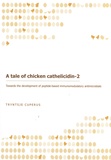A tale of chicken cathelicidin-2
Towards the development of peptide-based immunomodulatory antimicrobials

Cuperus, Tryntsje
- Promoter:
- Prof.dr. H.P. (Henk) Haagsman
- Co-promoter:
- Dr. A. (Albert) van Dijk
- Research group:
- Haagsman
- Date:
- June 21, 2016
- Time:
- 14:30 h
Summary
Increasing antibiotic resistance and an ever stricter control on the use of antibiotics are a driving force to develop alternative means of infection prevention and treatment. A promising alternative is the use of Host Defense Peptides (HDPs). HDPs are important effector molecules of the innate immune system with both antimicrobial and pleiotropic immunomodulatory functions. In this thesis the potential of the chicken HDP cathelicidin 2 (CATH-2) is investigated to serve as a template for the development of anti-infectives for the poultry industry. Firstly, expression of endogenous CATH-2 and avian β-defensin 9 (AvBD9) was examined in chicken embryos and developing chicks. AvBD9 was predominantly found in enteroendocrine cells throughout the intestine, the first report of in vivo HDP expression in this cell type, and showed stable expression levels during development. CATH-2 was exclusively found in heterophils; these cells decreased after hatch in most of the examined organs including spleen, bursa and small intestine. In two infection experiments, the stable D-amino acid analog of CATH-2 (D-CATH-2) was administered to chickens, either in ovo at 3 days before hatch or intramuscularly posthatch. Using in ovo injection of labelled CATH-2 peptides, uptake of the peptide by the embryo was seen from 4 hours after injection onwards followed by accumulation in the gastrointestinal and respiratory tract. Importantly, in ovo D-CATH-2 administration partially protected chicks against a systemic Salmonella infection or a respiratory E. coli infection in the first week posthatch. Lower mortality and greatly reduced morbidity based on lesion scores was seen. In the E. coli infection model, D-CATH-2 treatment reduced airsac bacterial loads at 7 days post infection. Intramuscular D-CATH-2 treatment at days 1 and 4 posthatch was less effective in protecting chicks against E. coli infection, while an additional intramuscular injection posthatch did not increase the protective effect of D-CATH-2 against Salmonella compared to in ovo treatment alone. In both infection models, in ovo D-CATH-2 treatment increased peripheral blood leukocyte and heterophil numbers at 2 days post infection and in addition, E. coli infection-induced lymphopenia was prevented. To investigate the mechanism responsible for this protection, immune status and microbiota of non-infected in ovo D-CATH-2 treated chicks were analyzed at 7 days posthatch. In three consecutive studies, no effects on numbers and functions of immune cells were found and only small changes were seen in gene expression of PBMCs. This indicates that D-CATH-2 does not affect the chick’s immune system in the absence of an infectious stimulus. Intestinal microbiota composition was highly variable between studies, suggesting it to be strongly influenced by environmental factors. In both studies, in ovo D-CATH-2 treatment caused significant reduction of Ruminococcaceae and Butyricicoccus in the cecum and Escherichia/Shigella in both ileum and cecum. In summary, this thesis present important steps in investigating CATH-2 as a template for new anti-infectives. Most importantly, protective effects of this peptide after in ovo administration have been shown against two important bacterial poultry pathogens, with efficacy up to 10 days after administration.